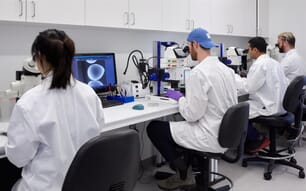Rohu carp is an extremely important aquaculture species in India. Farming of carp in Asia is of far greater significance to global food supply than Norwegian salmon farming.
The database of gene sequences from rohu carp contains more than 137,000 gene sequences and is an important resource for future genetic resource, says Senior Scientist Nicholas Robinson from Nofima, who has headed the Norwegian component of this Norwegian-Indian collaborative project which began in 2008.
The goal of the project is to give carp and tiger shrimps, another important aquaculture species in India, improved resistance against disease. The aquaculture environments in the project comprise smaller dams for farming shrimps and carp, which are run by poor farmers in rural areas.
Serious diseases
The diseases furunculosis and white spot syndrome virus (WSSV) have had a dramatic negative impact on aquaculture production of carp and shrimps, both in India and on a global basis. By developing tests and methods to improve resistance against these serious diseases, the project will make a significant contribution to more sustainable and productive aquaculture in this region.
Outbreaks of white spot syndrome virus can result in 100 percent mortality at the fish farms, says Nicholas Robinson.
The research team is now about to identify genes that may be linked to disease resistance in rohu carp.
Genetic resource
One hundred of the 50,000 genetic markers (single nucleotide polymorphism or SNP) which have been identified show differences in gene expression between lines of rohu carp which were initially selected for high and low resistance to disease. The results indicate that the more resistant fish expresses other genes or has more of the single gene segments than less resistant fish. This may be utilised in the future work to increase resistance against disease and shows the benefit of the database.
We have also identified more than 136,000 gene sequences for the tiger shrimp. More than 50 per cent of the established DNA segments represented previously unknown genes, says Mr Robinson. Consequently, the comprehensive gene mapping provides a large potential to find genes of importance for disease resistance and other important characteristics in farmed shrimps.
The Nofima scientist, who originates from Australia, refers to good experiences from the collaboration and communication with the Indian scientists.
We have had challenges concerning authorship, distribution of work and use of sub-suppliers. For instance, we had some difficulties and delays during the start-up phase of the project in India because of uncertainty on the Indian side about local funding arrangements. But all the uncertainties have been resolved with advance planning and good implementation of the project, says Mr Robinson.
The large amounts of data developed through the project will form the basis for applications for additional funding and, as such, a continuation of the valuable work. In the first instance this will be beneficial for the Indian fish farmers, but it may also contribute to increased food production in India.
New tool
The project has been useful for both parties. Among other things, the alliance has given the Norwegian partners a tool that may be used in new projects involving species such as salmon and cod.
This collaboration has contributed to raising the professional profile in both India and Norway, which is important in this area as it is rapidly becoming a major research field internationally, concludes Senior Scientist Nicholas Robinson.
Combating Disease In Shrimps & Carp
NORWAY and INDIA - Norwegian and Indian scientists have identified and registered gene sequences in rohu carp and shrimps. The result is extensive databases of the genetic material in aquaculture species.





